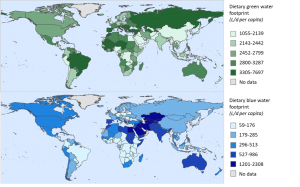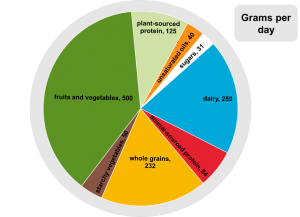Changes to human diets could reduce water scarcity

Each year, four billion people suffer from water scarcity, where demand exceeds supply. This number is increasing as population growth and rising incomes are leading to greater water use. Furthermore, climate change is exacerbating water scarcity by altering rainfall patterns.
In order to reduce the threat of insufficient water, we need to reduce our water use. The greatest potential for this is through changes in food production, as this is where the majority of human water use lies. Around two thirds of all the water used each year is in agriculture, much more than is used by industry or in our domestic needs. Different foods require different amounts of water to grow, depending on the crop type as well as the climate they are grown in. Scientists have therefore been carrying out research to understand if changes to our diets could reduce water use, but this research has yet to be brought together and summarised.
Water use can be measured using the water footprint, which indicates the volume of water used in the production of an item. It can be separated out into rainfall use, known as “green water”, or ground and surface water use, known as “blue water”. We searched for all studies that have quantified how much water is used by different diets using the water footprint, and combined findings to understand 1) how these varied by different global regions, 2) how these varied by different food consumption patterns.
We found 41 eligible studies for our analysis. The dietary water footprints ranged between 700 to 8000 litres per person per day. When we consider that only 100 litres of water a day is sufficient for hygiene and drinking needs, we can see that our food uses substantially more.
There was considerable variation in the water footprints of diets between different global regions. This is because crops will require different amounts of water depending on the climate or local agricultural practices. European diets use the largest amount of rain water in their production – an average green water footprint of 3000 litres per person per day. However, diets in Asia use the largest amount of blue water – around 400 litres per person per day. Although this is much less than the total water used, blue water reserves are rapidly depleting in many parts of Asia. Consequently, food production and therefore food security is highly vulnerable in this region.

Switching from current dietary patterns to healthier ones – such as those recommended in dietary guidelines – could reduce the total dietary water footprint by an estimated 6%. Given that these diets are also nutritionally better, this could additionally improve public health. However, healthier diets don’t use less blue water, which is the most diminishing water resource. If individuals made more extreme changes to diets, such as removing all animal products, the total dietary water footprint could decrease by 25%, and the blue water footprint by 12%. Notably, these are only summary estimates from all studies, therefore the actual potential for change will vary by specific contexts.

By exploring the “hidden water” used through our food consumption, we can begin to understand how dietary change could alleviate some pressure on global water resources. We have shown that individuals can reduce their dietary water footprint by eating healthier. By eating less animal products their water use can be reduced further. This is in line with other recent research such as the EAT-Lancet Commission report that suggests predominantly plant-based diets are better for the environment. We did not explore how these diets would affect human health, nor outline specific diet changes in different contexts, therefore more research is needed to establish clear recommendations.
Francesca Harris, Cami Moss, Edward J M Joy, Ruth Quinn, Pauline F D Scheelbeek, Alan D Dangour, Rosemary Green, The Water Footprint of Diets: A Global Systematic Review and Meta-analysis, Advances in Nutrition, https://doi.org/10.1093/advances/nmz091

